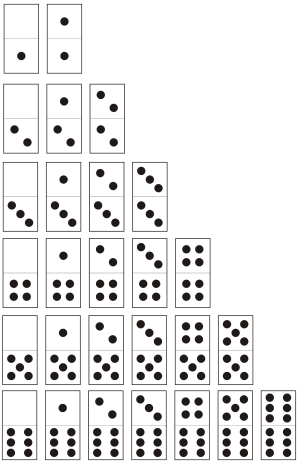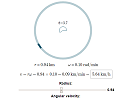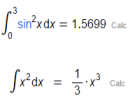IntMath Newsletter: Angular velocity, face numbers, WIRIS
By Murray Bourne, 31 Oct 2016
31 Oct 2016
In this Newsletter:
0. Ad blockers
1. Linear & angular velocity applet
2. Your face in numbers: Microsoft's Face Detection app
3. Resource: WIRIS Calc
4. Math movie: Conspiracy theories & math
5. Math puzzles
6. Final thought
0. Ad blockers
Most of us cannot imagine how we'd cope without Google, YouTube, Facebook and Twitter. What keeps all of these coming into our lives for free? It's the same thing that's kept magazine, newspapers, television and other news services alive for many years: advertising.
Yes, you can easily block the ads on Google, YouTube, Facebook and Twitter, but please consider the outcome if everyone does that. All those services — and IntMath as well — would disappear.
1. Linear & angular velocity applet
2. Your face in numbers: Microsoft's Face Detection app
Face detection is a fast growing research area because of its many applications in the security arena.
On that page there's also "Face verification" to detect if 2 photos are of the same person, and also video face analysis near the bottom.
This could make a motivating class project on data gathering and intepretation.
3. Resource: WIRIS Calc
You can also save your worksheet to your local computer, to the Cloud, or as a PDF. Here's the documentation.
4. Math movie: Conspiracy theories & math
As I write, the debate about which US election conspiracy theory to believe continues to rage.
If you can vote in this, the worst election in living memory, please do.
5. Math puzzles
a. Bus route problem: The earlier problem (in the 29 Aug 2016 Newsletter) has been solved! Narendrakumar got the correct number of bus routes.
b. Domino puzzle: The puzzle in the last IntMath Newsletter asked about the sum of the fractions formed by the tiles in a domino set.
There was only one attempt to solve it, by Bill, and he was correct. (He gave 2 answers using different assumptions. but his first answer addresses the original conditions of the puzzle.)

The first row gives us (0 + 1)/1 = 1
The second row is (0 + 1 + 2)/2 = 3/2
The third row is (0 + 1 + 2 + 3)/3 = 2
And so on.
New math puzzle
 |
A sheep is placed in a circular fenced pen where it can chew grass all day. The farmer wants to make sure there is enough grass left in the pen for the following day, so she ties the sheep to one of the fence posts using a rope. How long does the rope have to be so the sheep can only eat half of the grass? |
You can leave your responses here.
6. Final thought: Responding
From the moment we're born, we start learning to respond to the things lfe throws at us. How much better off we'd all be if we saw each bad (and good) experience as a learning opportunity. It's all in our approach.
There's nothing in your life you can't learn from, if you respond with the right attitude. [Rick Warren]
Until next time, enjoy whatever you learn.
See the 20 Comments below.




31 Oct 2016 at 8:52 pm [Comment permalink]
The rope should be equal to the circular fence diameter divided by two
1 Nov 2016 at 4:57 pm [Comment permalink]
It all depends on the size of the pen and whether the sheep is capable of eating half of the grass within it in the given time
1 Nov 2016 at 8:51 pm [Comment permalink]
Hi Murry
Love your information on maths
Do you know Rick Warren? I have read his book
Cheers
Laurie
3 Nov 2016 at 11:26 am [Comment permalink]
I look forward to the solution for the sheep problem. It did my head in.
Regards
Rhonda
4 Nov 2016 at 2:49 am [Comment permalink]
How many words we can get from the word " gammon " .. please I want to know the style of solution>>> thanks
4 Nov 2016 at 11:04 am [Comment permalink]
Hello Karam
This would be a good question for the IntMath Forum. Here's the appropriate section: https://www.intmath.com/forum/counting-probability-8/
4 Nov 2016 at 9:34 pm [Comment permalink]
Problem: construct a little circle inside a bigger circle so that the area of the little circle is 1/2 the area of the larger circle.
The area of the large circle is defined as: A=(pi)(R*R) where R is its radius.
The area of the smaller circle will be A(little)= (pi)(R(little)*R(little).
We want A(little)=1/2(pi)(R*R)
Substituting we find that R(little)=R/(square root of 2); which is approximately R/1.414.
So, from any point on the large circle, we would follow on a straight line to a point that equals R/1.414; take one of the fence posts from the enclosure and put it at that point, secure the goat with a corresponding length of rope.
Parenthetically, on the second day, the farmer can replace the fence post and let the goat run free inside the larger circular enclosure.
9 Nov 2016 at 4:25 am [Comment permalink]
I'm sorry, Dave. I'm afraid I can't do that.
Something messed up. :-(